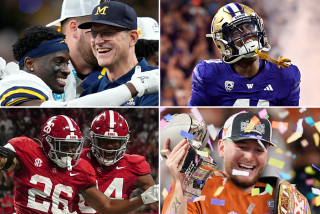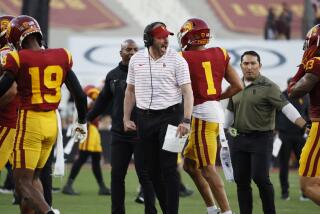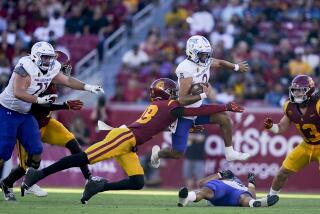Cyclones Came Up Short in the Bid for a Big Upset
This is the introduction of a column, analyzing game strategies, scheduled for this space on Saturdays.
Florida State almost lost its chance for an undefeated season, and--who knows?--maybe the national championship, in its opening game last Saturday at Kansas City against Iowa State.
The game came down to the final play. Fortunately for the Seminoles, Iowa State Coach Dan McCarney chose that play to over-coach.
With the Seminoles leading, 38-31, Iowa State had the ball at the Florida State one-yard line with four seconds remaining. One play. The pressure was on McCarney to call the right one.
Deciding which player he wanted to handle the ball was easy because Cyclone quarterback Seneca Wallace had been ripping through the Florida State defense all game.
In leading Iowa State back from a 24-0 deficit, Wallace had accounted for three of the Cyclones’ four touchdowns. Time after time, he bought extra time against the Seminoles’ pass rush to throw for 313 yards, completing 22 of 33 passes, two of them for touchdowns. He also was getting the job done on the ground, directing the Cyclones’ option attack to 130 yards.
Florida State Coach Bobby Bowden, who needed the victory to pass Bear Bryant for second place on the all-time victory list, couldn’t devise a way to stop Wallace.
Wallace had set up the game’s dramatic final play with a 20-yard scramble and seemed primed to score again.
*
“We wanted to give the ball to the best player on the team,” said McCarney, who was hoping to lead Iowa State to its first victory against a ranked team in 29 games.
But the play he chose for Wallace was not a good one.
In college football, the hash marks are 53 feet 4 inches from the sideline, compared to 60 feet in the pros. This gives college offenses more working room inside the marks, but leaves them with a very short side.
With the ball on the right side of the field, McCarney figured Florida State would stack up on the wide side to stop Wallace, who had scored on an option run in a similar situation earlier in the game.
McCarney thought he would pull a fast one and run the same type play--but to the short side of the field. Big mistake.
What McCarney should have realized is that a player like Wallace needs running room. McCarney ended up making Florida State’s job easier because the sideline serves as an extra defender on the short side of the field.
McCarney went with his main goal-line offense, which uses two tight ends instead of two wide receivers. That allowed Bowden to go with four linebackers, a strength for Florida State.
Another bad decision for Iowa State was to use motion before the snap. The Cyclones had been putting their fullback, Joe Woodley, in motion all game to get better blocking leverage on the option. Once the Seminoles saw Woodley in the motion to the short side of the field, the Cyclones were done.
*
Wallace never had a chance. Florida State linebacker Jerel Hudson and cornerback Kendyll Pope teamed to stuff him at the goal line to end the game. Once Pope stepped up and forced Woodley to break downfield, he took away Wallace’s option to make a quick pitch to tailback Hiawatha Rutland, who had rushed for 93 yards and a touchdown.
“As soon as I saw the fullback go in motion, I knew it was coming,” Hudson said. “They ran it before and I guess they thought that they could run it again on us.
“I just tried to stay behind the ball. I got him inside out. Kendyll got him outside in and we got him stopped.”
If Wallace had scored, McCarney indicated he would have gone for a two-point conversion rather than play for the tie. But that became a moot point after Wallace was stopped.
“We wanted to see if [Wallace] could make something happen,” McCarney said about his final play call. “If we had to do it again, we’d still put the ball in his hands.”
And, assuming McCarney had learned from his mistake, he would call the play to the wide side of the field.
More to Read
Go beyond the scoreboard
Get the latest on L.A.'s teams in the daily Sports Report newsletter.
You may occasionally receive promotional content from the Los Angeles Times.










